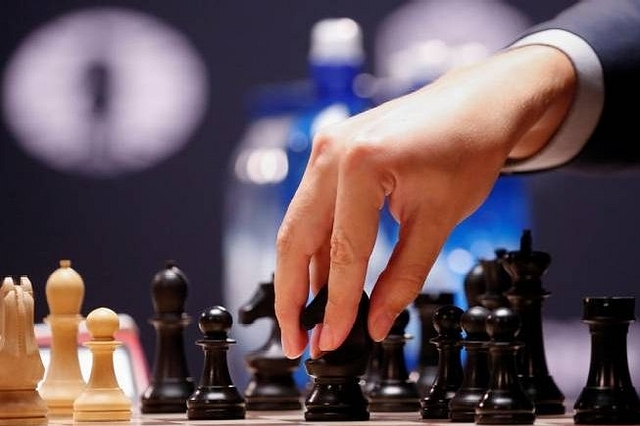
Magnus Carlsen To Play In World Fischer Random Chess Championship Final Today; Here’s Why This Version Of The Game Is Also Called Chess960
Why is the number of possible starting positions 960 in Fischer Random Chess?
This question can be answered using combinatorics, which forms the very heart of chess.
The first FIDE World Fischer Random Chess Championship is currently underway at Bærum, Norway, with Magnus Carlsen set to face Wesley So in the final. Fischer Random Chess, a variant of chess conceptualised by former world chess champion Bobby Fischer (1943–2008), is also known as Chess960 for its 960 possible starting positions.
Why is the number of possible starting positions 960 in Fischer Random Chess? This question can be answered using combinatorics, which forms the very heart of chess.
What is Fischer Random Chess?
In Fischer Random Chess, the chessboard and pieces are the same as in standard chess but the starting position is randomised with the following conditions:
(1) All white pieces (except pawns) are on the first rank (row) and all pawns are on the second rank.
(2) The two white bishops are placed on squares of opposite colour.
(3) The white king is placed between the two white rooks.
(4) The initial position of all black pieces mirrors that of the white pieces, with all pawns on the seventh rank and all other pieces on the eighth rank.
Why are there 960 possible opening positions?
As black pieces mirror white pieces, we need to consider only the number of possible starting positions for white, ie, number of positions which satisfy conditions (1) to (3) above, to compute the number of possible starting positions.
In addition, as all the eight pawns are on second rank, we need to consider only the unique combinations of the eight white pieces except the pawns (one king, one queen, two rooks, two bishops, and two knights) on the first rank.
In how many ways can eight pieces be placed on eight squares? For the mathematically inclined, the instant answer is the number of permutations of a set of eight elements, which is 8! = 40,320. For others, the answer can be derived as follows.
The first piece can be placed on any of the eight empty squares, the second on any of the remaining seven empty squares, the third on any of the remaining six empty squares, the fourth on any of the remaining five empty squares, and so on. So the number of ways eight pieces can be placed on is 8 x 7 x 6 x 5 x 4 x 3 x 2 x 1 = 8! = 40,320.
However, we have three pairs of identical pieces (two rooks, two bishops, and two knights). Two positions which differ only by swapping the first and second rooks are the same position (same is true for bishops and knights).
So we need the number of unique ways in which the eight pieces with three identical pairs can be placed on eight squares. For the mathematically inclined, the instant answer is 8! / ( 2! X 2! X 2! ) = 40,320 / 8 = 5,040.
For others, the answer can be derived as follows. Let us say we place the pieces one by one from left to right. Among the 40,320 positions, there are as many positions where first rook is placed before (to the left of) the second rook as those where the second rook is placed before (to the left of) the second rook. So we are down to 40,320 / 2 = 20,160 positions where the placement of rooks is unique.
We use the same logic for the unique placement of bishops and knights. In this way, the number of positions with unique placement of the eight white pieces on the first rank is 40,320 / (2 x 2 x 2 ) = 5,040. These 5,040 unique positions satisfy condition (1) above.
As per condition (2), the bishops must be placed on squares of opposite colour. On first thought, it may appear this probability is 1/2, but actually this probability is 4/7. This is clear to the mathematically inclined — once we fix the position of the first bishop, there are seven squares available for the other bishop out of which four are of the opposite colour and three are of the same colour; hence the probability is 4/7.
For others, this probability can be derived simply by counting. There are only 8 x 7 / 2 = 28 unique starting positions for the bishop pair out of which 16 have bishops on squares of opposite colour — (a1, f1), (a1, h1), (b1, c1), (b1, e1), (b1, g1), (c1, d1), (c1, f1), (c1, h1), (d1, e1), (d1, g1), (e1, f1), (e1, h1), (f1, g1), and (g1, h1). The probability is thus 16/28, which is same as the answer 4/7 obtained earlier.
Of the 5,040 unique positions which satisfy condition (1), four out of seven satisfy condition (2). And so we have 5,040 x 4 / 7 = 2,880 unique positions which satisfy conditions (1) and (2).
Now we consider condition (3), that the king must be between the two rooks in the remaining six squares which are not occupied by the bishops. For the mathematically inclined, the answer is obvious — this probability is 1/3.
For others, the probability can be obtained by counting — the three possible placements from left to right are (king, rook, rook), (rook, king, rook), and (rook, rook, king), out of which the king is between the two rooks in only the second case.
Out of the 2,880 unique positions which satisfy conditions (1) and (2), one out of three satisfies condition (3). And so we have 2,880 x 1 / 3 = 960 unique positions which satisfy conditions (1), (2), and (3).
Due to these 960 possible starting positions, Fischer Random Chess is also called Chess960.